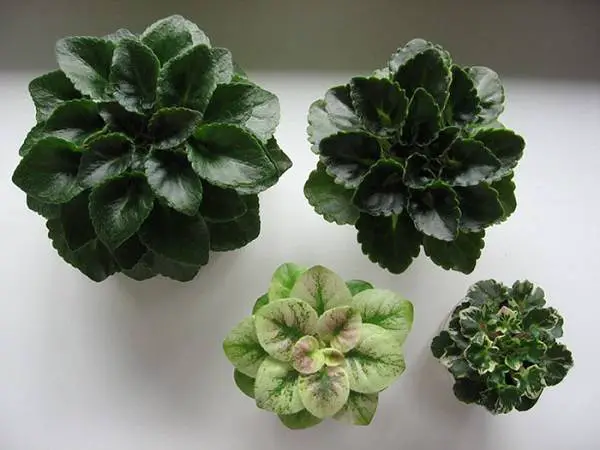Many people ask African violet too many leave whether it is possible to trim the leaves of violet is one of the most burning and controversial among gardeners. In this article, we’ll take a closer look at the following topics:
- is it possible to cut the lower leaves;
- whether it is necessary to trim the leaves if there are a lot of them;
- how to properly cut the leaves of a room violet to form a beautiful rosette.

African violet too many leaves
When such an African violet arises, the first step is to establish the cause. As a rule, errors in agricultural technology and the maintenance of violets lead to this.
Advice! Instead of removing the “extra” leaves, you just need to adjust the conditions in which the african violet grow.
The reasons for African violet too many leaves can be the following:
- a lot of light– it is necessary to rearrange the violet to a darker place and reduce daylight hours, then the cuttings will begin to stretch, the rosette will become looser;
- overfeeding with nitrogen fertilizer – stop feeding the plant, and after 1.5 – 2 months water with a preparation with a high phosphorus content or change the substrate to a “poorer” one;
Thickening of the outlet due to nitrogen overfeeding.
- watering with hard water – water the flower with cooled boiled, distilled or filtered water;
- acidified earth – transplanted into fresh soil ;
- large capacity – transplant into a smaller pot ;
- infection with a fungal disease – root the leaf plate and try to treat the mother plant with fungicides;
- tick damage – treat with acaricides until the pest is completely destroyed, root the cutting.
Your African Violet Leaves Curling Down and you want a solution.
Removal of lower and diseased leaf of african violet
Old, diseased, damaged violet leaves must be removed. The point is not even to provide a beautiful view of the plant, but to preserve its health:
- old leaf plates, no longer needed by the flower, draw off nutrients ;
- diseased become a source of infection for the entire plant;
- damaged can serve as conductors of various diseases through wounds.
Any bad leaves should be removed.
Having decided whether it is necessary to cut off the lower leaves, as well as those affected by the disease, we proceed to the practical part.
There are two ways to remove leaves from african violet:
- Cut with a razor, scalpel or utility knife . It is necessary to cut off under the base so that there is no hemp left. If it remains, it can serve as a pathway for bacteria to enter. The cut must be powdered with activated carbon. Work with a sharp knife carefully so as not to damage the african violets trunk or other leaves;
- Long-time collectors prefer to break out sheet plates . This is done as follows: take a leaf with two fingers at the very base of the petiole and gently pushing it to the right or left side. It will separate from the barrel with a distinctive sound, leaving no hemp behind. Coal can be sprinkled over the break-off point, but this is usually not done.
There are times when it is necessary to remove a leaf from the middle of the outlet :
- to get planting material for propagation ;
- the outlet, as a result of an excessive amount of illumination, is very dense and the peduncle cannot break through to the light;
- a diseased or damaged leaf is in the middle of the outlet.
How to remove excess leaves in this case:
- if the african violets rosette is still young and the peduncle has not yet appeared from the axil of the leaf that needs to be removed, then the leaf is cut off so that a small stump remains. It will need to be powdered with activated carbon;
- in an adult violet, the leaf plate is broken off at the base.
Advice! It is possible, but not desirable, to remove leaves from a blooming violet. Since the plant is still injured and part of the energy is spent on wound healing.
Pruning of leaves is carried out preferably in the spring when the saintpaulia wakes up. Removing excess leaf blades in the spring stimulates flowering because nutrients are not spent on maintaining old leaf plates, but on the formation of peduncles. By the way, here lies the answer to the question of whether it is necessary to pick off the leaves from the violets so that they bloom.
Facing problem African Violet Leaves Turning Yellow?
make beautiful rosette of african violet by leave cutting
A beautiful rosette of Saintpaulia will look when each subsequent row of leaves overlaps the previous one and no gaps are visible between them.

Different varieties of violets may differ slightly, within the limits of the basic conditions of detention, in terms of care and requirements for temperature and lighting. Therefore, in order to form a beautiful outlet, these conditions will have to be determined empirically.
Deformation of the rosette can occur not only due to weak or one-sided lighting on the windowsill, high or low temperature, but also when the violets are very close or when planting in a large pot.
To correct the situation, the rosette must be formed by removing excess leaves, transplanted and in the future to avoid repeating such mistakes.
For abundant full flowering, the rosette should consist of at least 3 rows of leaves. There are varieties of violets that will not begin to lay flower stalks until they gain green mass, this can be more than 3 rows.
Before breaking off the leaves, you need to determine which ones should be removed and which ones should be left to form the rosette. This can be done as follows:
- if you look at the plant from above, then each layer of leaf plates should form a circle with a center at the point of growth and leaves radiating out radially, like spokes in a wheel;
- leaf plates should overlap each other, like fish scales;
- the petioles of the leaves left should be rigid, of the same length;
- if the Saintpaulia is young, not yet blooming, then before forming a rosette and transplanting it into a permanent pot, it is necessary to give it the opportunity to grow green mass;
- before transplanting, all undersized, adolescent leaves should be removed, and those on which the characteristics of the variety are not visible;
- if, after removing the “wrong” leaf plates, the stem is strongly exposed, then it must be deepened.
If in winter the violet was kept at a lower temperature, then new leaves develop on shorter petioles. Then the following picture is obtained – the lower sheet plates protrude strongly beyond the upper part of the outlet.
Do the lower leaves need to be removed if they are much larger than the rest of the rosette? Yes, they also need to be removed, and if the trunk is very bare, then the African violets are transplanted or the trunk is buried.
Violet with a bare trunk should be transplanted.
Check out How To Prune An African Violet?
Conclusion
When growing violets, it must be remembered that a beautiful healthy rosette is a key to an abundant and long-lasting bouquet bloom. When forming a plant, you do not need to get carried away, breaking off all those leaf plates that you simply do not like. It should be remembered that the leaves are the nutrient factory of African violets and should not be removed without a good reason.